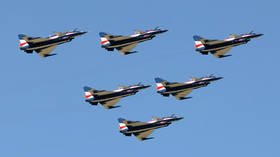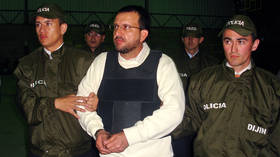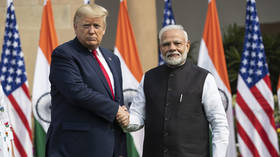The US cannot defend Taiwan, and China knows it

The US is playing a dangerous game of putting a public face on a policy of defending Taiwan from China, for which it has zero capability to implement.
Following a recent escalation of tensions between Beijing and Taipei, Chinese President Xi Jinping vowed on Saturday to pursue “reunification” with Taiwan by peaceful means and warned foreign nations about meddling in the issue.
For the past several years, the air force of the People’s Republic of China has been flying sorties into Taiwan’s Air Defense Identification Zone, or ADIZ, as a means of sending a signal to Taipei that China does not recognize its claims of independence and, as such, any notion of an ADIZ is null and void. These incidents, which have been escalating over the years, recently reached a crescendo: China, according to Taipei, flew 38 aircraft in two waves into Taiwan’s ADIZ on October 1, 39 more on October 2 (also in two waves), and 16 the following day.
In response, the US State Department spokesman Ned Price issued a statement. “The United States is very concerned by the People’s Republic of China’s provocative military activity near Taiwan, which is destabilizing, risks miscalculations, and undermines regional peace and stability. We urge Beijing to cease its military, diplomatic, and economic pressure and coercion against Taiwan.”
China’s Foreign Ministry Spokesperson Hua Chunying replied “Taiwan belongs to China and the US is in no position to make irresponsible remarks. The relevant remarks by the US side seriously violate the one-China principle and the stipulations of the three China-US joint communiqués and send an extremely wrong and irresponsible signal.”
On October 4, Taipei said that China sent its largest wave of aircraft yet into Taiwan’s ADIZ, some 56 in total, including 36 J-16 and Su-30 fighter jets, 12 nuclear-capable H-6 bombers, 2 Y-8 anti-submarine warfare (ASW) aircraft and two KJ-500 airborne early warning and control (AEW&C) aircraft.
Alarmed by these developments, Taiwan’s President Tsai Ing-wen declared that “Taiwan does not seek military confrontation. It hopes for a peaceful, stable, predictable, and mutually beneficial coexistence with its neighbors. But Taiwan will also do whatever it takes to defend its freedom and democratic way of life.”
‘Whatever it takes’, however, is an infinite concept backed up by the finite reality that Taiwan has a military of about 165,000 active-duty troops and about 1.6 million reserve soldiers which has been equipped with billions of dollars of advanced American-made military equipment.
While Taiwan’s military may look good on paper, it is ill-prepared for the realities of the kind of full-scale combat that will be directed at them if China ever decides to go through with an invasion. As the world learned in Afghanistan, impressive numbers on paper do not automatically translate into an impressive fighting force on the ground. And China would be delivering violence on a scale several orders of magnitude above what the Taliban could ever contemplate.
If China ever decided to invade Taiwan, the working assumption would be that it had conducted an extensive intelligence-based assessment of its chances of victory, which would have to be near-certain in order for China to undertake an action that would bring with it the condemnation of much of the world. China would have located with pin-point precision the garrisons and deployment locations of every major Taiwanese ground combat unit. It would have done the same with every combat-capable aircraft in the Taiwanese inventory. And it would have identified the logistics bases used by Taiwan to sustain its frontline combat forces. All of these would be subjected to extensive pre-assault bombardment by the Chinese air and ballistic missile forces.
Any surviving Taiwanese units would then be faced with the daunting task of repelling a massive invasion which would likely comprise a combination of amphibious and air assault forces. Assuming enough units survived the pre-assault bombardment to put up a competent defense, they would rapidly run through their on-hand stocks of ammunition, fuel, and food. Units that were cut off from resupply would begin to surrender, and the notion of surrender would become contagious. Pockets of die-hard defenders could survive to fight on for a period, but the reality is that Taiwan would fall in less than a week.
Also on rt.com 25 jets & bombers: Taiwan reports incursion by Chinese air force as Beijing celebrates PRC’s 72nd anniversaryMuch has been made about the US ability to come to Taiwan’s defense. While the US may have made great waves sailing its navy through the Taiwan Strait, such a maneuver would be suicidal in a time of conflict. The US Navy would be relegated to standing by far to the east of Taiwan, out of the range of China’s deadly ballistic missile capability, launching aircraft which would have limited combat capability given fuel and weight limitations. The same holds true for the US Air Force. The fact is, any aircraft the US dispatched to defend Taiwan from a Chinese invasion would be rapidly attritted, with no replacements available in a time frame that could change the course of the battle on the ground in Taiwan.
Much has been made about media reports concerning the presence of US forces in Taiwan for the purpose of training the Taiwan military. These forces are not part of any formal alliance or defense pact, but rather part of what is known as “foreign internal defense” training missions, in this case involving a few dozen US Special Forces and US Marines doing small-unit training. This is not the kind of large-scale operational training undertaken by formal alliances such as NATO, where interoperability is essential for any joint combat operations.
The best the US could hope to do when it comes to defending Taiwan would be to modify existing warplanes for the reinforcement of South Korea. This war plan, known as OPLAN-5027, has a subsection known as a Time-Phased Deployment List, or TPFDL, which has identified the forces and equipment necessary to reinforce South Korea in time of war. At one time, the TPFDL had earmarked 690,000 troops, 160 Navy ships, and 1,600 aircraft for deployment from the US to South Korea within 90 days of a war breaking out on the Korean peninsula.
Two things come to mind—by the time the US cavalry was ready to arrive in Taiwan, they would be about 83 days too late. And, more importantly, China would have consolidated its hold on Taiwan making any US effort to retake it suicidal. OPLAN-5027 envisions US forces flowing into South Korean ports that are controlled by the South Korean government. It is not an amphibious assault plan, and any effort to transform it into one would fail.
Also on rt.com Not stopping at ‘provocative military activity,’ US demands China halt even ‘diplomatic & economic pressure’ towards TaiwanThis is the reality-based state of play today when it comes to the defense of Taiwan by the US. The only alteration that could be made would be for the US to use nuclear weapons in defense of Taiwan. This, of course, would trigger a general nuclear war with China, and the US is not prepared to commit national suicide for a nation it doesn’t even have a formal defensive pact with.
Ned Price might want to keep all of this in mind the next time he approaches the microphone to speak about defending Taiwan. He and the rest of the US government are writing checks with their mouths neither Taiwan nor the US military can cash. A better course of action would be to work with China and Taiwan toward the goal of peaceful unification which preserves intact the democratic system of government that exists in Taiwan.
Like this story? Share it with a friend!
The statements, views and opinions expressed in this column are solely those of the author and do not necessarily represent those of RT.
















